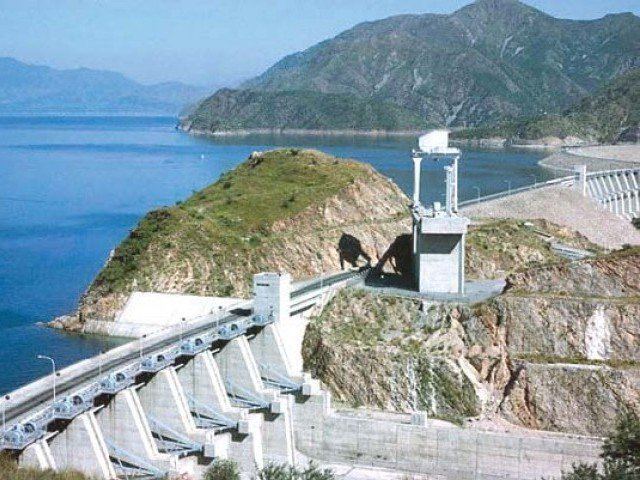Country Pakistan Height 79 m | Status Proposed Length 3,350 m (10,991 ft) Catchment area 286,194 km² | |
 | ||
Active capacity 7.52 km (6,100,000 acre·ft) Type of dam Embankment dam (zoned fill embankment with clay core) Similar Tarbela Dam, Diamer‑Bhasha Dam, Mangla Dam, Gomal Zam Dam, Munda Dam | ||
The Kalabagh Dam (Urdu: کالا باغ ڈيم), is a proposed hydroelectric dam on the Indus River at Kalabagh in the Mianwali District of Punjab Province in Pakistan. Intensely debated, if constructed the dam would have 3,600 megawatts (4,800,000 hp) of electricity generation capacity.
Contents
- Map of Kalabagh Dam Pakistan
- History
- Technical facts
- Conflict and Debate
- In favour
- Controversy and opposition
- References
Map of Kalabagh Dam, Pakistan
History
In December 2004, then President of Pakistan General Pervez Musharraf, announced that he would build the dam to serve the larger interest of Pakistan. However, on 26 May 2008, the Federal Minister for Water and Power of Pakistan, Raja Pervez Ashraf, said that the "Kalabagh Dam would not be constructed" and that the project had been cancelled due to "opposition from Khyber Pakhtunkhwa, Sindh and other stakeholders, the project was no longer feasible". In 2010 after the worst floods in Pakistani history, the Prime Minister of Pakistan, Yousaf Raza Gilani, stated flood damage would be minimised if the Kalabagh Dam were built.
Technical facts
Bashir A. Malik, former chief technical advisor to the United Nations and World Bank, said, "Sindh and Pakhtunkhwah would become drought areas in the years to come if Kalabagh Dam was not built." At the same time, former KP Chief Minister Shamsul Mulk has stated that the "Kalabagh Dam would be helpful in erasing poverty from Khyber-Pakhtunkhwa, as it would irrigate 800,000 acres of cultivable land that is located 100–150 feet above the level of River Indus." The Kalabagh Dam would provide 6.5 million acre feet of water to cultivate seven million acres of currently barren land in addition to the 3,600 megawatts (4,800,000 hp) of electricity it would provide. In response to the push towards side-lining Kalabagh altogether in favour of the rival Basha Dam project, Engineer Anwer Khurshid stated that "Basha Dam is no substitute for Kalabagh Dam, not because of its altitude, which is high enough, but because no irrigation canals can be taken out from it because of the hilly terrain."
Experts who supported the construction of the Kalabagh Dam at the 2012 "Save Water Save Pakistan" Forum included: Dr Salman Shah, former Finance Minister of Pakistan; Abdul Majeed Khan, TECH Society president; Shafqat Masood, former IRSA chairman; Qayyum Nizami, former Minister of State; Prof Abdul Qayyum Qureshi, former Vice-Chancellor of Islamia University, Bahawalpur; Dr Muhammad Sadiq, agricultural scientist; M Saeed Khan, former GM of Kalabagh Dam Project; Engr. Mahmudur Rehman Chughtai, Mansoor Ahmed, former MD of Pakistan Atomic Energy Commission Foundation, M. Zubair Sheikh and Jameel Gishkori, among others. The participants of Save Water Save Pakistan demanded the construction of five dams, including the Munda Dam, Kurram Tangi Dam, Akhori Dam and the Kalabagh Dam, at by 2025 at the latest to store water and generate electricity to meet demand.
Conversely, former Water and Power Development Authority (WAPDA) Chief Engineer, Engr. Shahr-i-Yar Khan has claimed that construction of the Kalabagh Dam is not suitable for Khyber Pakhtunkhwa and will involve significant fiscal waste when compared to the many other suitable sites for proposed dams on the Indus River. Shahr-i-Yar Khan, who has trained abroad and served in various positions at the WAPDA, highlighted various issues related to construction of the dam, stating that it would have a number of adverse effects on the generation capabilities of the Barotha power complex.
Conflict and Debate
Pakistan Economy Watch suggested the government to make consensus and start a debate on the KBD issue. A Feaseability report is also published in the research gate .
In favour
An independent panel convened by the World Bank in the late 1980s supported the recommendations of the Project Planning Report. The Pakistan & Gulf Economist reported in 2003 that "One of the major reason for the insistence to build a storage dam at Kalabagh is that it is the only option ready for immediate implementation supported by number of surveys and feasibility studies costing billions of rupees."
Muttahida Qaumi Movement (MQM) chief Altaf Hussain also conditionally supported the Kalabagh dam and said that government should address the reservations of Sindhis before its construction.
Controversy and opposition
Kalabagh dam is condemned by the Khyber Pakhtunkhwa and Sindh . The Government time to time tries to make consensus on the issue . The leader of Opposition in the National Assembly Syed Khurshid Ahmed Shah showed objection on the site of Kalabagh Dam and said its a threat to small provinces. The Chief Minister of KPK Pervez Khattak said that the KBD is against the interests of KP. Awami National Party has opposed the construction and site of KBD.
The Sindhi Association of North America published a seven objections on the Kalabagh dam, which includes shortage of water, Kotri down stream devastation. Sustainable Development Policy Institute published a case study on Kalabagh dam.
